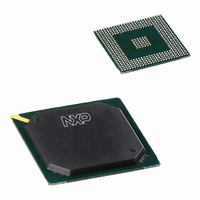PNX1502E,557 NXP Semiconductors, PNX1502E,557 Datasheet - Page 124

PNX1502E,557
Manufacturer Part Number
PNX1502E,557
Description
IC MEDIA PROC 300MHZ 456-BGA
Manufacturer
NXP Semiconductors
Specifications of PNX1502E,557
Applications
Multimedia
Core Processor
TriMedia
Controller Series
Nexperia
Interface
I²C, 2-Wire Serial
Number Of I /o
61
Voltage - Supply
1.23 V ~ 1.37 V
Operating Temperature
0°C ~ 85°C
Mounting Type
Surface Mount
Package / Case
456-BGA
Lead Free Status / RoHS Status
Lead free / RoHS Compliant
Program Memory Type
-
Ram Size
-
Lead Free Status / Rohs Status
Not Compliant
Other names
935274744557
PNX1502E
PNX1502E
PNX1502E
PNX1502E
Available stocks
Company
Part Number
Manufacturer
Quantity
Price
Company:
Part Number:
PNX1502E,557
Manufacturer:
NXP Semiconductors
Quantity:
10 000
- Current page: 124 of 828
- Download datasheet (8Mb)
Philips Semiconductors
Volume 1 of 1
PNX15XX_SER_3
Product data sheet
6.3 System Parameters for TM3260
Few more control parameters are available to tune the use of TM3260 and PNX15xx
Series. The MMIO register layout and offsets are described in
Remark: It is not recommended to have the TM3260 to flip itself to ‘1’ the
TM32_PWRDWN_REQ bit.
•
•
•
The CPU apertures (DRAM and APERT1 described in
modified by the TM3260 itself, if the TM32_APERT_MODIFIABLE bit is set to ‘1’.
In host mode the host CPU can decide to prevent TM3260 to go out of its allowed
apertures by flipping to ‘0’ the bit TM32_APERT_MODIFIABLE.
The TM32_LS_DBLLINE and TM32_IFU_DBLLINE parameters influence the
overall performance of the TM3260. These parameters are related to the cache
line sizes and the optimal memory burst than can be obtained with PNX15xx
Series MMI. The default values favor the main memory bandwidth usage and
improve, in most cases, the TM3260 processing power. However some
applications may require a shorter memory burst to reduce the bandwidth usage
or to avoid some pathological cache trashing cases. TM32_LS_DBLLINE and
TM32_IFU_DBLLINE can then be flipped to ‘0’. There is no available formula to
know if a particular application benefits from one setting or the other.
Experimentation on the final application is recommended to determine the
optimal settings.
It is possible for a host CPU to shutdown entirely the high speed clock of the
TM3260. The safe procedure consists in first requesting the TM3260 to prepare
itself for major powerdown mode. The host CPU needs first to alert the software
running on the TM3260 that a powerdown sequence is coming. The TM3260
software acknowledges that it is ready. Then the host CPU toggles the
TM32_PWRDWN_REQ bit to inform the TM3260 module that a full powerdown
mode is requested. The TM3260 hardware state machine replies by asserting the
TM32_PWRDWN_ACK bit. From this point TM3260 will not answer to any
request and its high speed CPU clock can be turned off by the CPU host. The
wake-up sequence starts by turning back on the high speed CPU clock and then
flip to ‘0’ the TM32_PWRDWN_REQ bit.
Rev. 3 — 17 March 2006
Chapter 3: System On Chip Resources
© Koninklijke Philips Electronics N.V. 2006. All rights reserved.
PNX15xx Series
Section
Section
2.2) can be
6.3.1.
3-15
Related parts for PNX1502E,557
Image
Part Number
Description
Manufacturer
Datasheet
Request
R
Part Number:
Description:
Digital Signal Processors & Controllers (DSP, DSC) MEDIA PROCESSOR PNX15XX/300MHZ
Manufacturer:
NXP Semiconductors

Part Number:
Description:
IC MEDIA PROC 300MHZ 456-BGA
Manufacturer:
NXP Semiconductors
Datasheet:
Part Number:
Description:
NXP Semiconductors designed the LPC2420/2460 microcontroller around a 16-bit/32-bitARM7TDMI-S CPU core with real-time debug interfaces that include both JTAG andembedded trace
Manufacturer:
NXP Semiconductors
Datasheet:

Part Number:
Description:
NXP Semiconductors designed the LPC2458 microcontroller around a 16-bit/32-bitARM7TDMI-S CPU core with real-time debug interfaces that include both JTAG andembedded trace
Manufacturer:
NXP Semiconductors
Datasheet:
Part Number:
Description:
NXP Semiconductors designed the LPC2468 microcontroller around a 16-bit/32-bitARM7TDMI-S CPU core with real-time debug interfaces that include both JTAG andembedded trace
Manufacturer:
NXP Semiconductors
Datasheet:
Part Number:
Description:
NXP Semiconductors designed the LPC2470 microcontroller, powered by theARM7TDMI-S core, to be a highly integrated microcontroller for a wide range ofapplications that require advanced communications and high quality graphic displays
Manufacturer:
NXP Semiconductors
Datasheet:
Part Number:
Description:
NXP Semiconductors designed the LPC2478 microcontroller, powered by theARM7TDMI-S core, to be a highly integrated microcontroller for a wide range ofapplications that require advanced communications and high quality graphic displays
Manufacturer:
NXP Semiconductors
Datasheet:
Part Number:
Description:
The Philips Semiconductors XA (eXtended Architecture) family of 16-bit single-chip microcontrollers is powerful enough to easily handle the requirements of high performance embedded applications, yet inexpensive enough to compete in the market for hi
Manufacturer:
NXP Semiconductors
Datasheet:

Part Number:
Description:
The Philips Semiconductors XA (eXtended Architecture) family of 16-bit single-chip microcontrollers is powerful enough to easily handle the requirements of high performance embedded applications, yet inexpensive enough to compete in the market for hi
Manufacturer:
NXP Semiconductors
Datasheet:
Part Number:
Description:
The XA-S3 device is a member of Philips Semiconductors? XA(eXtended Architecture) family of high performance 16-bitsingle-chip microcontrollers
Manufacturer:
NXP Semiconductors
Datasheet:

Part Number:
Description:
The NXP BlueStreak LH75401/LH75411 family consists of two low-cost 16/32-bit System-on-Chip (SoC) devices
Manufacturer:
NXP Semiconductors
Datasheet:

Part Number:
Description:
The NXP LPC3130/3131 combine an 180 MHz ARM926EJ-S CPU core, high-speed USB2
Manufacturer:
NXP Semiconductors
Datasheet:

Part Number:
Description:
The NXP LPC3141 combine a 270 MHz ARM926EJ-S CPU core, High-speed USB 2
Manufacturer:
NXP Semiconductors

Part Number:
Description:
The NXP LPC3143 combine a 270 MHz ARM926EJ-S CPU core, High-speed USB 2
Manufacturer:
NXP Semiconductors

Part Number:
Description:
The NXP LPC3152 combines an 180 MHz ARM926EJ-S CPU core, High-speed USB 2
Manufacturer:
NXP Semiconductors











